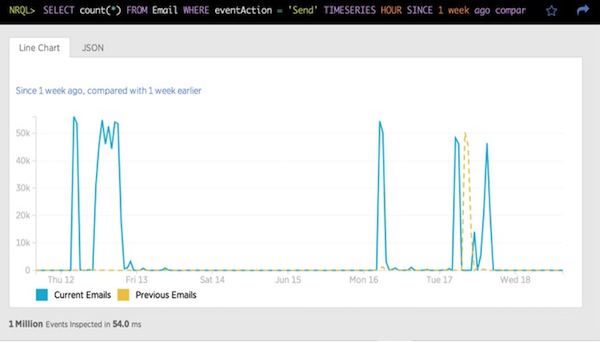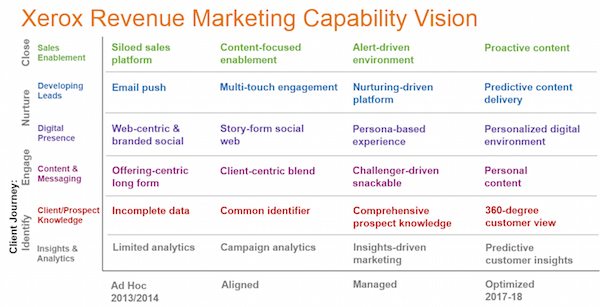Marketing automation may be all the rage with the best of today’s tech-savvy marketers, but fundamentally it’s just another software engineering problem abstracted to a pretty user interface (albeit with a fraction the functionality of the most basic scripting languages). Those of us who spend any time building program flows in a marketing automation platform should really be called “Marketing Engineers.” Systems thinking and flow control are every bit as important in a tool like Marketo as they are in software engineering, like in a MVC patterned web application.
That’s the opening paragraph — with emphasis added by me — of a terrific post that Isaac Wyatt of New Relic published last summer on his company’s blog, Using Insights with Marketo Webhooks to Build Real-time Dashboards and Analytics.
On one level, it was a product announcement post. New Relic is a software analytics and application performance management company that has primarily served the software development and “DevOps” communities. This announcement, however, was a toe in the water, illustrating how their products could be applied to support and enhance marketing technologies such as marketing automation.
But on another level, wow, I feel like Isaac perfectly captured in his post the gestalt of the emerging marketing technologist movement. The reason marketing needs hybrid marketing technologists — professionals with technical talents and a passion for applying them in marketing — isn’t mostly because there are a lot of marketing technologies out there, and somebody needs to figure that all out. Yes, that’s a related reason, but not the central one.
The raison d’être of marketing technologists is that the actual design and operation of marketing programs now has many of the characteristics of software engineering. You need people in the marketing team who can lead and manage that layer of software and data dynamics.
I am incredibly excited that Isaac will be one of our featured speakers at MarTech — which is almost here, in less than 3 weeks! — giving a TED-style talk titled: Marketing Automation Is Engineering, Marketing Operations Is DevOps.
In the meantime, Isaac and his co-collaborator, Baxter Denney, New Relic’s director of marketing operations, joined me for a Q&A around these topics.
1. Tell us a little about your backgrounds and your current roles.
[Isaac]: I am currently the manager of marketing operations at New Relic, a fast growing software analytics firm. I have a team focusing on four primary areas: 1) marketing automation, 2) marketing analytics, 3) sales and marketing alignment, 4) marketing technology.
My career has always been about enabling people, whether in sales or in marketing, to be as efficient and effective as possible, using whatever tools and processes are necessary — automating where possible, enabling where necessary. I was previously with other technology companies that experienced tremendous growth like Citrix and Blue Jeans Network.
[Baxter]: Currently, I head up the marketing operations team at New Relic. I’ve served on both the consulting side and client-side, where I focused on marketing operations, automation, and technology. Prior companies I’ve worked at include Couchbase and Citrix.
2. Isaac, you’re going to be presenting at MarTech shortly on the topic of “Marketing Automation is Engineering.” What do you mean by that?
[Isaac]: The similarities between marketing and engineering are rather astounding.
Marketers who are in charge of designing, implementing, and deploying automation programs — whether it is nurturing campaigns or lead data flows — have to think how those new programs will, or will not, interact with existing automated flows, existing processes. They also have to think about the people who will interact with them now and potentially in the future as the system changes. At the same time, they have to be building the platform for maximum flexibility and preserve future implementation options, to avoid being stuck with legacy programs that are hard to dismantle.
For example, there are times when I’ve seen companies build a lead assignment workflow that doesn’t scale when they go international, due to the way sales territories get drawn. Rebuilding it requires a complete overhaul of the system that disrupts lead flow for a short time.
In fact, engineers have a term for those legacy programs that are hard to dismantle: “technical debt.”
Engineers (should) have the same types of considerations when they are designing, building, and deploying their software. In fact, engineers have a term for those legacy programs that are hard to dismantle: “technical debt.” I think engineers have had more experience in figuring out best practices in protecting the user experience, and we marketers could learn a lot about building better systems using the same set of principles as they do.
3. How did that insight come about? What does that mean for the evolution of marketing and the marketing team?
[Isaac]: I was fortunate enough to cut my teeth on marketing automation during the early days of SaaS, and I was responsible for answering business questions about “why thing-x did or did not happen?” I almost always found that marketing automation platforms had little capability to troubleshoot quickly and effectively, to answer why certain events did or did not happen.
Fast forward almost 10 years, when I had just started at New Relic. I started exploring one of our most popular products, Insights, and realized that even though it was a tool designed for engineers and developers to understand what is going on under the hood of their software, it could also be used as a great tool for marketers to get better visibility into what was happening inside their marketing automation platform.
Shortly after I implemented the integration between our marketing automation platform and Insights, I realized just how similar the issues that marketing automation and engineering folks are facing actually are. This realization caused a paradigm shift in my thinking for the type of people who should be running and managing marketing automation.
Systems thinking, as taught in many computer science disciplines, is a concept and skill that marketing automation specialists need to possess in order to be successful in their role.
First, systems thinking, as taught in many computer science disciplines, is a concept and skill that marketing automation specialists need to possess in order to be successful in their role.
Second, the specialist must also be capable of forecasting potential unexpected interactions between automated processes, called emergent behaviors, that could have a high positive — or negative — impact for their companies.
Third, splitting the development cycle of marketing automation programs into phases like design, build, and implementation, with considerations in UX, QA, and UAT, is key to launching large programs that have broad reach in the marketing database or across the salesforce.
Fourth, and perhaps most importantly, strategic thinking is necessary when choosing how to decide when a process or program has outlived its usefulness — or if and when it is appropriate to introduce a new tool, process, or program. Sort of like how DevOps folks have to help software engineers introduce new, seemingly “profane” changes to the code-base and software environment, while simultaneously protecting the “sacred” core virtues of a platform or a system so that it minimizes disruption to the organization’s customer.
4. What’s your view of how marketing operations has changed over the past few years? Where is it headed?
[Baxter]: It’s super exciting that companies are investing so much, both and people and resources. When I first got into marketing operations as a discipline, it was really focused on managing technology, specifically marketing automation, and maybe some basic reporting.
Now a high-performing marketing ops team is managing everything from the technology to advanced analytics to the customer lifecycle to planning, both budget and workforce. Successful marketing ops teams are adding value throughout the funnel and are making everyone else in marketing better at their jobs.
5. What between marketing operations and IT? What about marketing operations and sales?
[Baxter]: Well, marketing ops and IT should be collaborative. I don’t think it’s a “versus” thing. Our goal at New Relic is to be very transparent with IT about our technological investments and where we hope they can add value. They want us to be responsive and flexible in dealing with things like information security, adding users, etc.
As far as sales go, there is no such thing as being too aligned. The key, I think, is to find common ground in metrics and be clear about what the goals are on both sides, then report on it regularly — or through an automated dashboard, ideally.
When it comes to ops teams on both sides, I think you have to agree on the set of joint projects — for example, improving velocity of qualified lead distribution to sales team — understand what each other is working on independently, and share results. Once you get to the point where you are in the same room with your counterparts in sales every single week and there’s nothing new to talk about because everyone is on the same page, you are probably approaching alignment.
6. New Relic has certainly gone through some amazing growth. How have you achieved agility in your team — and, more broadly, across marketing — as you’ve scaled up?
[Baxter]: This is certainly a challenge for some organizations. What those organizations inevitably end up realizing is that they underinvested in certain areas and now need to scramble to keep up. I think marketing ops can actually play a big part here by tracking how the team is growing, where the skills and competencies are, and where there are gaps to inform the team building strategy.
We try to set short-ish deadlines, focus on getting out first versions, and then iterating quickly to improve.
As far as day to day work goes, while we don’t use the term “agile marketing,” that concept applies to how we work. We try to set short-ish deadlines, focus on getting out first versions, and then iterating quickly to improve.
[Isaac]: Agreed. Being too formal with a process or being too prescriptive with “how” to get things done is a sure way to alienate teams or introduce crippling bureaucracy. Instead, we like to focus on what needs to get done. We trust each other to have scoped and defined the request thoroughly, and that it will get done in scope and on time. We escalate and rework the project scope when there is a resource or organizational constraint.
7. Bonus question: can you give us a high-level view of your marketing stack at New Relic?
[Isaac]: Without getting too deep into specifics, we do take a strategic view of our marketing technology stack, and we employ a cloud-first, build-your-own type of approach — as opposed to the “buy your cloud” approach.
This maximizes our team’s flexibility and number of options, minimizes infrastructure requirements, and lets us create an ecosystem of integrated marketing technologies that maximizes value for our customers and New Relic through the entire customer lifecycle.
All potential marketing tech vendors must have a comprehensive set of APIs already live, so that the sharing of data between apps is as seamless and thorough as possible.
All potential marketing tech vendors must have a comprehensive set of APIs already live, preferably with built-in integrations to marketing automation platforms, so that the sharing of data between apps is as seamless and thorough as possible. Also, we continuously evaluate newer vendors who are creating entirely new categories — or solving an existing problem better than industry incumbents.
One example is Infer, which does predictive lead scoring, and they have direct, seamless integrations into our CRM and marketing automation platform, which scores our inbound leads. That is table stakes, but because they also have an API, we can use Infer to score leads from syndicated sources. This means that we can have our lead generation partners score their leads and decide which ones to send us first, without us having to add them to our system. The result has been that we our sales team is not only more productive, but because of the API, we can quantitatively measure the quality of leads we are getting from some of our partners before they are even imported into our system.
Thanks, Isaac and Baxter — I’m looking forward to seeing you at MarTech!





Great parallels Scott (and Isaac) and certainly something I’ve noticed in my evolution from a programmer to marketing technology.